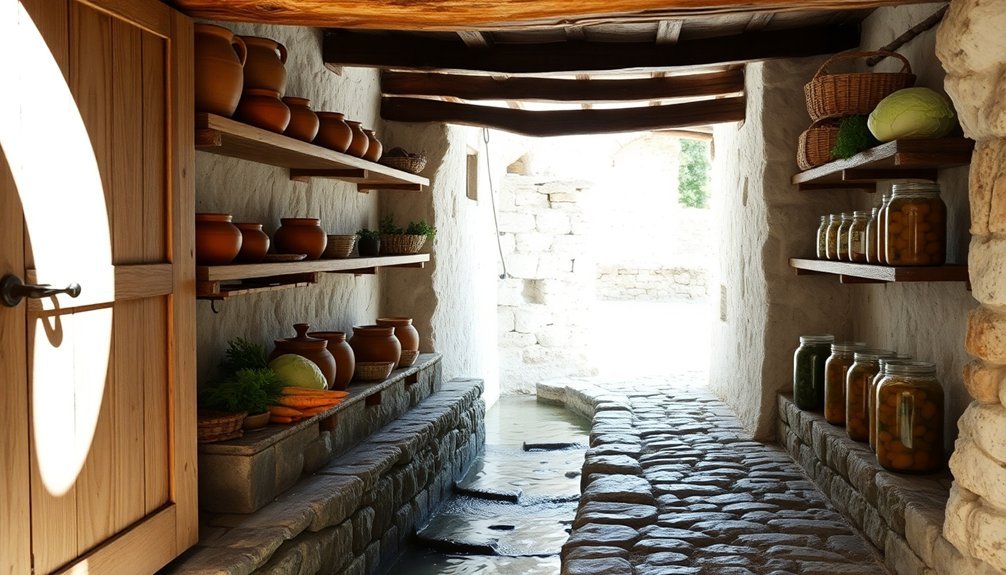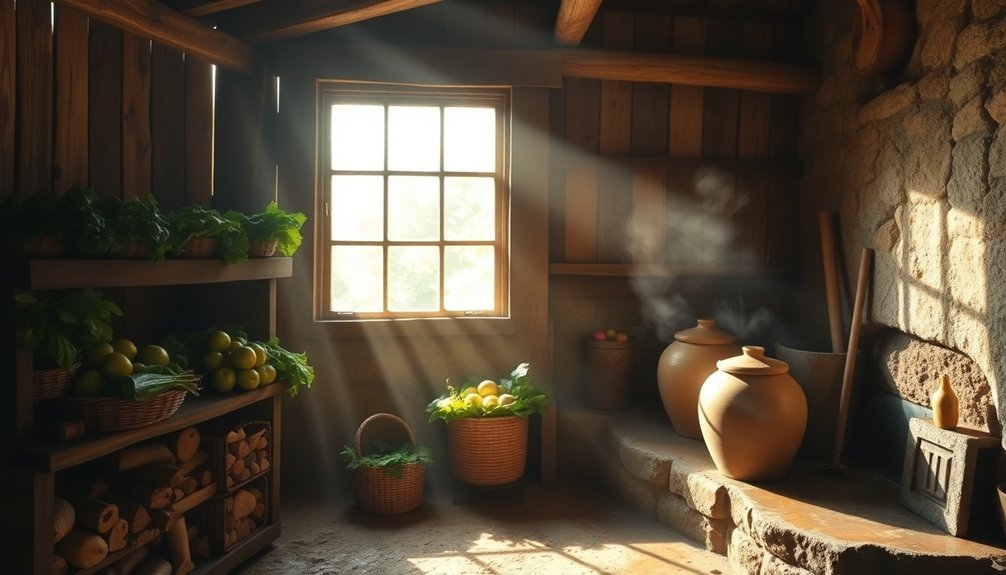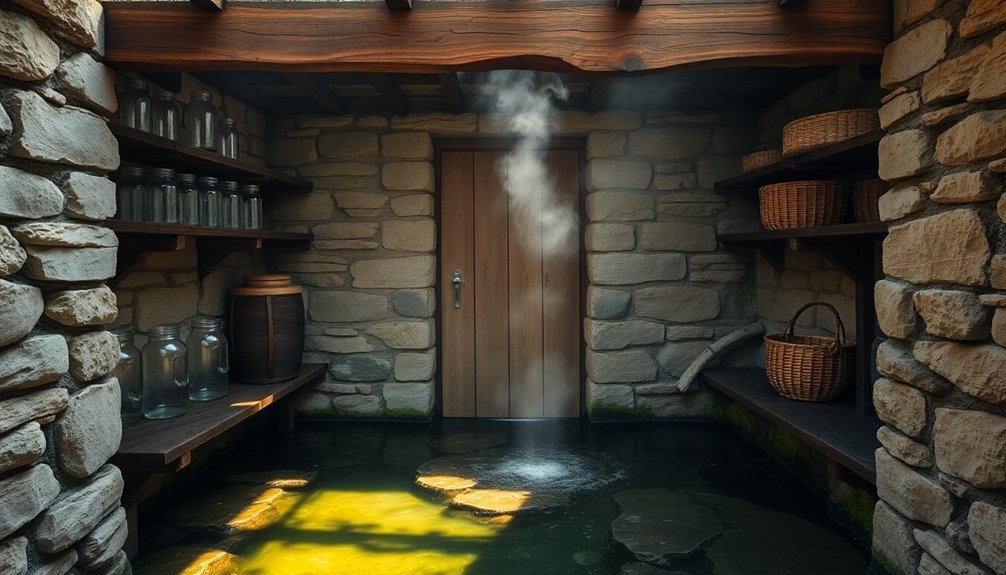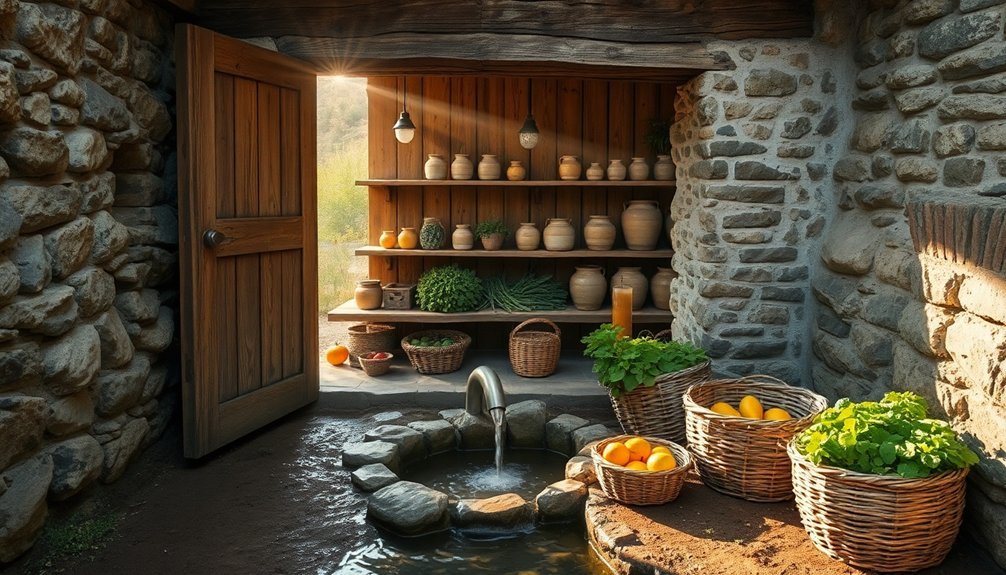You'll find spring houses offer an eco-friendly way to preserve fresh produce without modern refrigeration. These traditional structures use natural spring water's cooling power (50-60°F) to maintain ideal storage temperatures and humidity levels. By building into a hillside and incorporating proper insulation, you can create distinct temperature zones for different crops. You'll need to focus on air circulation, proper moisture levels (85-95% for most produce), and organized storage areas to maximize freshness. Good maintenance and seasonal adjustments guarantee your spring house keeps fruits and vegetables at peak quality. The secrets of this time-tested method can transform how you store your harvest.
Why Spring Houses Still Matter

The humble spring house stands as a proof to sustainable food preservation in our modern age.
You'll find these traditional structures offer remarkable benefits that align perfectly with today's environmental and health concerns. By utilizing the natural cooling power of spring water, you're reducing the need for energy-intensive refrigeration while maintaining ideal temperatures for your perishable foods. Storing produce in spring houses helps maintain their peak nutritional value throughout the seasons.
When you store your produce, meat, and dairy products in a spring house, you're not just preserving food – you're participating in a sustainable practice that reduces your carbon footprint. You won't need artificial preservatives or excessive packaging, and you'll keep your food fresh naturally. The constant cool temperature protects your food from spoilage while maintaining its nutritional value, ensuring you're getting the most from your locally sourced products.
You're also supporting your local economy when you use spring houses. They enable local farmers to store their harvest effectively, helping them provide fresher products to the community.
Natural Cooling Through Water Flow
Spring houses demonstrate the power of natural cooling, but understanding how water flow creates this cooling effect helps you maximize its capacity. The key lies in the consistent temperature of spring water, which typically emerges between 50-60°F. When you channel this naturally cool water through your spring house, you're creating a sustainable cooling system that requires minimal energy input.
To harness water flow effectively for cooling, consider these essential principles:
- Direct water flow through designated channels to maintain peak temperature transfer
- Install flow regulators to control water movement and prevent overflow
- Use heat exchangers to enhance cooling efficiency in larger spaces
- Guarantee proper insulation around water channels to maintain cool temperatures
- Create access points for regular maintenance and cleaning
You'll find that even a modest flow rate of 1/4 gallon per minute can effectively cool a small storage area. The water's natural movement creates a cooling effect through heat exchange, as warm air releases its heat to the cooler water. A well-designed spring house can provide up to 1,440 gallons daily when operating at full capacity.
Designing Your Spring House

When planning your spring house design, successful construction begins with thoughtful site selection and proper structural considerations.
You'll want to locate your spring house near a natural water source while avoiding areas with high water tables or septic systems. Choose a well-drained spot, ideally built into a hillside, to maximize natural insulation and guarantee proper water drainage. Using clay or wood materials provides traditional, time-tested building options for spring house construction.
Build your structure using stone or earth materials to maintain consistently cool temperatures. Keep the design simple with a single room and include channels to direct water flow around the building. Install a sturdy door to control access and protect against wildlife.
Inside, you'll need strategic storage solutions, including sturdy rafters for hanging items and built-in shelves for stoneware containers.
Incorporate proper ventilation to prevent moisture buildup and maintain ideal storage conditions. You'll find it helpful to create separate storage zones for different types of produce, using ventilated containers and partially below-ground storage where possible.
Remember to insulate with natural materials like straw or hay, and plan for regular maintenance checks to prevent water damage, pest infestations, and mold growth.
Optimal Temperature Control Methods
You'll want to harness natural cooling techniques by placing heat-sensitive produce toward the back of your storage area while keeping hardier items near the front.
To maintain proper temperature zones, you can adjust your ventilation seasonally and use crushed ice for delicate greens during warmer months.
Your cold zone layout should follow a temperature gradient, with items needing 32-35°F stored furthest from entry points, while keeping 45-55°F items closer to the front where temperature fluctuations are more common.
Natural Cooling Techniques
Three primary natural cooling techniques have revolutionized the way farmers and producers maintain fresh produce quality.
You'll find that night air ventilation, radiant cooling, and underground storage methods offer effective temperature control without relying on mechanical systems. By utilizing cool night air, you can naturally lower storage space temperatures, while radiant cooling takes advantage of night sky conditions to reduce ambient heat.
Underground storage solutions like root cellars and caves provide consistently cool environments, making them ideal for long-term produce storage.
You'll also benefit from incorporating these proven shade-management strategies:
- Position storage buildings under natural tree cover
- Install shade cloth over packing areas
- Use light-colored building materials to reflect sunlight
- Create ventilated storage spaces that maximize airflow
- Build storage facilities at higher elevations when possible
When you're managing storage environments, it's essential to match the cooling method to your specific produce needs.
For instance, garlic and onions thrive in cool, dry conditions, while berries and mushrooms require cool, moist environments.
Seasonal Temperature Adjustments
Successfully managing seasonal temperature adjustments requires precise control over multiple storage zones to accommodate diverse produce requirements.
You'll need to establish distinct temperature ranges for different crop types, with cool-season crops stored at 32-35°F and warm-season produce at 45-55°F. For ideal results, monitor your storage areas using recording thermometers and maintain refrigeration coil temperatures within 2°F of the room's air temperature.
You'll want to adjust your storage conditions based on seasonal produce shifts. During spring and summer, when you're handling more warm-season crops and berries, create separate zones to maintain appropriate temperatures.
Set up your tropical fruits like pineapple in warmer areas (50-55°F), while keeping leafy vegetables in the coldest sections (30-31°F). To maintain freshness, you'll need to manage humidity levels between 80-95% by wetting floors or using moisture barriers.
Don't forget to monitor storage duration carefully. You can keep broccoli and cauliflower in the coldest parts for up to two weeks, while corn needs warmer temperatures and should be used within 2-3 days.
Remember to regulate air movement based on your storage room load and guarantee proper heat ventilation through external escape outlets.
Cold Zone Layout
Efficiency in cold storage layout begins with strategic chamber design and temperature zoning. You'll want to focus on creating fewer, larger chambers rather than multiple small ones, as this approach reduces construction costs and simplifies your refrigeration control systems.
When you're planning your cold storage facility, consider how temperature requirements vary among different produce types.
For ideal cold zone organization, keep these critical factors in mind:
- Chamber dimensions must accommodate your total merchandise volume and handling equipment like forklifts and rails
- Most produce requires storage temperatures between 2° and 4°C, but you'll need separate zones for items needing higher temperatures
- Limit your facility to five or six cold chambers maximum for best operational efficiency
- Install advanced sensors and monitoring systems throughout each zone for precise temperature control
- Design uniform airflow patterns to guarantee consistent cooling throughout each storage area
Your layout should prioritize storage density while maintaining accessibility.
Remember to factor in space for traffic flow and potential future expansion. By implementing proper temperature zoning and utilizing modern refrigeration technology, you'll maximize both storage efficiency and produce freshness.
Produce Organization By Temperature Zones

Proper organization of fresh produce according to temperature zones plays an essential role in maintaining quality and extending shelf life.
You'll need to organize your storage space into four distinct temperature zones to guarantee ideal freshness.
In the warmest zone (above 10°C), you'll store tropical fruits like pitaya and bananas at 15°C with 75-90% humidity. This zone's also perfect for ripening unripe fruit, but remember not to keep soft fruits too long.
Around 10°C, you'll want to keep water-rich produce like lychee, plum, cucumber, pumpkin, and tomatoes. These items need careful monitoring and regular rotation to prevent spoilage.
The 2-8°C zone is perfect for green beans and root vegetables like potatoes and sweet potatoes. Store these at 3-5°C, but don't place them in storage immediately after harvest – give them 24 hours at room temperature first.
For your coldest zone (0-2°C), arrange root vegetables, leafy greens, and fruits like cherries, apples, grapes, peaches, and pears. Keep the temperature just above freezing to prevent damage while slowing down metabolic processes and bacterial growth.
Managing Humidity Year Round
A balanced humidity level stands at the heart of effective produce storage. You'll need to manage different humidity zones throughout the year to keep your produce fresh longer. Most vegetables and leafy greens thrive in high humidity environments (85-95%), while items like onions and garlic prefer drier conditions (50-75%).
To maintain ideal humidity levels, you can use simple tools and techniques year-round:
- Place humidifiers near high-humidity produce storage areas, or keep a dish of water nearby to naturally increase moisture.
- Store moisture-loving produce in perforated plastic bags or sealed containers in your refrigerator's crisper drawer.
- Use mesh bags or baskets for items requiring lower humidity, allowing proper air circulation.
- Monitor humidity levels with a hygrometer and adjust ventilation accordingly.
- Keep ethylene-producing fruits separate from other produce to prevent premature ripening.
During seasonal changes, you'll need to adapt your storage methods. In winter, when indoor heating reduces humidity, consider using humidifiers or sealed containers.
During humid summers, increase ventilation and use dehumidifiers if necessary. Remember to check your storage areas regularly and adjust conditions based on how your produce responds.
Air Circulation Fundamentals

While produce may seem stationary in storage, air must constantly flow around it to maintain freshness. You'll need proper air circulation to remove heat from respiration, prevent condensation, and reduce moisture loss while keeping ethylene gas from building up around your stored fruits and vegetables.
When setting up your storage area, make sure you're using vented containers with holes covering at least 5% of their surface area. Stack your boxes or bins so the vents align, creating clear pathways for air movement.
You'll want to maintain air velocities above 1m per second for effective cooling, which you can achieve through various methods like forced-air cooling or tunnel coolers.
You can optimize your storage space by installing fans with thermostats that automatically adjust to maintain consistent temperatures. Don't forget to leave adequate spacing between packages and shelves to allow air to flow freely.
If you're using hydrocooling or vacuum cooling methods, you'll still need proper air circulation afterward to prevent moisture-related issues. Remember to adjust your airflow based on your produce type, as different fruits and vegetables have varying respiration rates and cooling needs.
Root Vegetable Storage Systems
Successful root vegetable storage depends on maintaining precise temperature, humidity, and ventilation conditions. You'll need to keep temperatures between 32-38°F and maintain humidity levels between 95-100% while ensuring proper air circulation.
Root cellars provide an ideal environment, but you can also create effective storage systems using insulated containers or underground pits.
To protect your harvest, you'll want to implement moisture control strategies using materials that maintain consistent humidity. You can bed your vegetables in slightly damp sphagnum moss, sand, or soil, making sure they don't become too wet or too dry.
- Store potatoes in ventilated bins away from light to prevent greening
- Keep parsnips wrapped in damp towels or buried in moist sand
- Place carrots and beets in sphagnum moss or damp sand
- Cure onions before storing them in mesh bags for proper airflow
- Store kohlrabi in perforated plastic bags in cold conditions
For best results, you can use burlap bags, wooden crates, or insulated containers lined with peat moss.
Remember to check your stored vegetables regularly and remove any that show signs of decay to prevent spread to healthy produce.
Dairy Product Preservation

Proper dairy product preservation combines multiple techniques to maintain freshness and guarantee food safety.
You'll need to focus on three key methods: pasteurization, refrigeration, and proper storage temperatures.
For everyday storage, you'll want to keep your dairy products between 3-4°C (37-39°F). This temperature range effectively slows bacterial growth without risking freezing damage.
If you're handling pasteurized milk, remember it'll last up to two weeks when properly refrigerated, while UHT milk can stay fresh for six months at room temperature.
When it comes to pasteurization methods, HTST (heating to 72°C for 15 seconds) preserves most nutritional properties while killing harmful bacteria.
For longer-term storage, UHT treatment (137-150°C for 2-9 seconds) provides commercial sterility without requiring refrigeration.
Don't freeze regular milk, as it can alter the composition and quality.
However, certain dairy products like cream can be frozen for industrial use or ice cream production.
If you're interested in extending shelf life further, fermented products like yogurt and kefir offer an alternative, lasting up to two weeks through the natural preservation process of converting lactose to lactic acid.
Seasonal Produce Rotation Tips
As you rotate your seasonal produce, implementing a First-In First-Out system helps you track freshness and minimize waste by using older items before newer ones.
You'll want to organize your storage space into specific temperature zones, keeping cold-loving crops like root vegetables separate from warmth-preferring produce such as tomatoes.
Creating clear labels with harvest dates and maintaining designated areas for different temperature requirements will make your rotation system more efficient and extend the life of your stored crops.
First-In First-Out Basics
Organization is key to managing seasonal produce effectively, and the First-In First-Out (FIFO) method serves as your foundation for smart storage rotation. When you're managing fresh produce in your cool storage, you'll want to guarantee older items are used first to prevent waste and maintain quality.
By implementing FIFO principles, you'll considerably reduce spoilage while keeping your produce fresh and safe for consumption.
To make FIFO work effectively in your cool storage, you'll need to establish clear labeling and systematic organization. Store newer produce behind or beneath older items, and always check dates before adding new stock.
You'll find this method particularly valuable when dealing with highly perishable items that need consistent rotation.
- Label all items with receipt and expiration dates for easy tracking
- Position older produce at the front or top for immediate access
- Conduct daily checks to monitor produce condition and rotation
- Organize storage spaces with clear loading and unloading zones
- Maintain separate areas for different produce types to prevent cross-contamination
Temperature Zone Planning
Temperature zone planning transforms your cool storage into an efficient system for seasonal produce rotation. You'll need to organize your space into distinct temperature zones to maximize the freshness of different crop types. Cool-season crops like broccoli and kale require temperatures between 32-35°F, while warm-season produce such as tomatoes and squash need 40-55°F.
| Crop Type | Temperature Range | Storage Tips |
|---|---|---|
| Leafy Greens | 32-35°F | High humidity, minimal air movement |
| Root Vegetables | 32-40°F | Dark storage, moderate humidity |
| Fruiting Crops | 45-55°F | Monitor ripening, adjust temps |
| Storage Crops | 40-50°F | Good ventilation, low humidity |
When you're setting up your zones, remember that some fruits continue ripening after harvest and should stay at room temperature until ready. Don't store potatoes in coolers, as cold temperatures convert their starch to sugar. You'll want to maintain consistent temperatures within each zone, keeping your refrigeration coil temperature within 2°F of the storage room air. Install humidifiers where needed and use moisture barriers in your storage containers to maintain ideal conditions for each crop type.
Building Materials and Construction

Building a cool storage facility requires three essential construction elements: proper insulation, airtight wall assemblies, and durable materials.
You'll want to focus on high-performance insulative materials like ICF blocks with EPS form inserts, which can achieve impressive R38+ ratings. These materials work together with insulated metal panels to create a robust thermal barrier that keeps your produce at ideal temperatures.
For maximum efficiency and sustainability, you'll find these key construction elements crucial to your project:
- Insulated Concrete Forms (ICF) that combine thermal mass benefits with superior insulation
- Prefabricated steel components for quick, precise assembly and long-term durability
- High-performance wall assemblies that prevent air leakage and moisture infiltration
- Properly ventilated wall systems to maintain perfect storage conditions
- Locally sourced, eco-friendly materials to reduce environmental impact
When selecting your building materials, consider your geographic location and climate conditions.
You'll need to integrate proper moisture control systems and guarantee your wall construction can withstand severe weather while maintaining consistent internal temperatures.
Remember that investing in quality materials initially will lead to significant energy savings and better temperature regulation over time.
Maintenance Throughout The Seasons
You'll need to adjust your storage temperatures regularly throughout the year, using thermometers to monitor both indoor and outdoor conditions and modifying ventilation accordingly.
Your monthly inspection routine should include checking for signs of spoilage, cleaning debris, and ensuring proper air circulation through vents and fans.
To maintain ideal humidity levels year-round, you can use materials like peat moss in storage bins and implement proper ventilation strategies that prevent excess moisture while avoiding produce dehydration.
Seasonal Temperature Adjustments Needed
Throughout the year, maintaining proper storage conditions for fresh produce requires careful monitoring and adjustment of temperature settings. You'll need to adapt your storage areas as seasonal temperatures fluctuate, ensuring your produce stays at ideal conditions.
For cold-loving crops like carrots and beets, you'll want to maintain 32°F during winter months, while adjusting ventilation in spring and fall to prevent temperature spikes.
During temperature changes, you'll need to make these key adjustments:
- Monitor basement temperatures daily during spring and fall, when outdoor temperatures fluctuate most dramatically
- Add insulation to storage areas during summer to maintain cool conditions for potatoes and other 40-50°F crops
- Relocate produce to cooler spots when temperatures rise, such as moving onions from the mudroom to the basement
- Install thermometers in different storage zones to track temperature variations throughout the day
- Use ice packs or frozen water bottles during heat waves to maintain stable temperatures for sensitive produce
For winter squash and sweet potatoes in warm storage, you'll need to protect them from cold drafts while maintaining 50-55°F.
Consider using portable heaters in uninsulated storage areas during extreme cold spells to prevent chilling injury.
Monthly Inspection Routines
Beyond seasonal adjustments, maintaining ideal produce storage requires a structured monthly inspection routine.
You'll need to start by checking the evaporator system, ensuring the fins and casing are clean, and verifying that blowers are functioning properly. Make sure to test the defrosting mechanism and reversed blowing function to prevent ice accumulation.
Inspect your door seals monthly, as they're critical for temperature stability. Look for wear, tears, or damage, and don't forget to lubricate hinges for smooth operation. Replace any compromised seals immediately to maintain proper cooling conditions.
Your monthly checklist should include examining the compressor for oil leaks and checking Freon levels. You'll want to verify that all check valves are working correctly and perform thorough system tests to catch potential issues early.
Keep the storage space organized by removing any damaged produce and maintaining proper air circulation.
When it's time for deep cleaning, remove all products first and use appropriate cold room cleaning chemicals on surfaces and floors. Clean up any spills promptly, whether it's water, oil, or organic matter, to prevent contamination and maintain ideal storage conditions.
Humidity Control Year-Round
Humidity management plays an essential role in year-round produce storage success. You'll need to actively monitor and adjust humidity levels throughout the changing seasons to maintain ideal storage conditions. Using a hygrometer, keep your storage area's relative humidity between 30-50% for general storage, adjusting higher to 90-95% for most fresh produce.
To maintain proper humidity control across seasons, implement these essential practices:
- Install and regularly operate exhaust fans in high-moisture areas like bathrooms and kitchens.
- Seal all air leaks around windows, doors, and foundations using weatherstripping and caulk.
- Keep interior doors open to promote consistent air circulation throughout your storage space.
- Use dehumidifiers in damp areas and humidifiers in dry zones as needed.
- Maintain proper insulation to prevent temperature fluctuations that affect humidity.
During winter months, you'll likely need to add moisture using water dishes or targeted sprinkler systems for leafy vegetables.
In summer, focus on moisture reduction through increased ventilation and dehumidification.
Remember to adjust your approach based on specific produce requirements – garlic and onions need 65-75% humidity, while most fruits and vegetables thrive at 90-95%.
Frequently Asked Questions
How Long Does It Take to Build a Functional Spring House?
You'll need 4-8 weeks to build a functional spring house, depending on your construction experience, available materials, site conditions, and weather. Planning and proper water flow setup are essential components.
Can Spring Houses Be Effective in Desert or Arid Climates?
You'll face challenges making spring houses work in desert climates due to limited water sources. You'd need significant modifications, like earth-sheltering and passive cooling systems, to achieve similar cooling effects in arid regions.
What Alternatives Exist if Natural Spring Water Isn't Available?
You can create effective cooling without springs by using evaporative cooling, underground root cellars, or insulated cooling chambers with circulating water systems. Solar-powered cooling units are also viable alternatives for produce storage.
Do Spring Houses Require Special Permits or Local Authority Approval?
Yes, you'll need building permits and zoning approval for your spring house. Check with your local planning department, as requirements vary. You may also need environmental permits if you're using natural water sources.
How Much Does Maintaining a Spring House Typically Cost Annually?
You'll spend around 1-2% of your spring house's value annually on maintenance, typically $500-$1,500, including structural repairs, waterproofing, drainage upkeep, and periodic cleaning to prevent mold and mildew buildup.
In Summary
You'll find that a well-maintained spring house offers more than just food storage – it's a sustainable solution that connects you to traditional preservation methods. Whether you're cooling dairy products or extending produce life, your spring house can serve as a reliable, eco-friendly alternative to modern refrigeration. By following proper temperature zoning and seasonal rotation, you'll enjoy fresh food storage while honoring this time-tested practice.





Leave a Reply